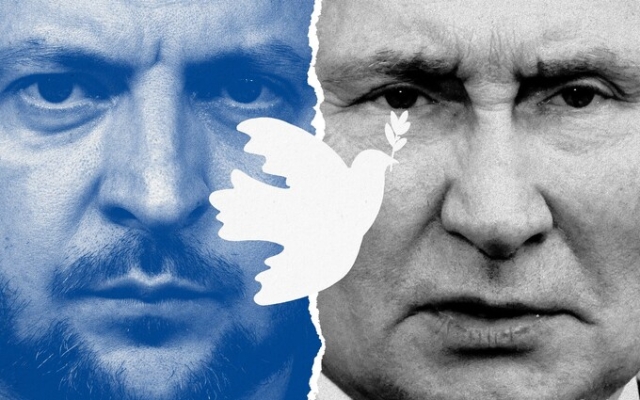
In the summer of 2022, I called my friends in Ukraine for several days. As the six-month anniversary of the full-scale invasion approached—a milestone few could have imagined seeing the tanks enter for the first time—I wanted to understand how they saw the war.
It was a difficult time. Kyiv was saved, but Mariupol and Severodonetsk lost, despite the heroic last battles. There seemed to be no answer to Russia's heavy artillery war in the Donbass. And on the sun-drenched summer battlefields, everyone knew that the government would not talk about losses because they were terribly high.
Despite this, everyone I spoke to believed that Ukraine would win. People told me the only question is how long it will last and at what cost.
This week the war reaches another milestone — its two-year anniversary — and peace seems as far away as ever. But this time the fatigue is much more noticeable, and the mood has changed.
“It’s tiring,” says MP from Odessa Alexey Goncharenko. “Everyone is thinking about only one thing: finishing it and as soon as possible. But the most depressing thing now is that there is no light at the end of the tunnel.”
Ukrainians are familiar with exhaustion, as well as the emotional and psychological rollercoaster of defeats and victories. They went through the mortal horror of a full-scale invasion in late February 2022; followed by the euphoria of victory in Kyiv a month later; the fall of Mariupol two months later; then victories in Kharkov and Kherson at the end of 2022; this was followed by the bloody loss of Bakhmut last year.
The mood on the front lines is now as grim as ever.
Last summer's offensive, which was supposed to force Vladimir Putin to the negotiating table, failed. Russia regained the initiative along the entire 600-mile front. The political hostage crisis in Washington has cut off critical supplies of American weapons, and Britain and Europe, despite promises, are not yet producing enough weapons to fill the gap.
The fall over the weekend of Avdiivka, a Ukrainian stronghold in the country's east that had resisted takeover during eight years of low-level war after Russia seized Crimea and the Donbass in 2014 and two years after a full-scale invasion, was a direct result.
The situation at the front is desperate. Troops in the Donetsk region told The Telegraph this week that they could not fire even when the Russians were at gunpoint. Instead, low on ammunition, they say they had to choose which village to withdraw from next. Scenes like these have intensified introspection among Ukrainians — and their Western allies — about how, if at all, the war could be ended. you can.
Four options
Donald Trump said he could end the war in 24 hours. – presumably by concluding a deal with Putin at the expense of Ukraine.
Ukrainian President Volodymyr Zelensky denied this last week, saying Trump could not simply resolve the conflict and inviting him to the front lines to see why.
The Russians are shelving the prospect of negotiations but say their goals have not changed , and still intend to capture Kyiv. And the Ukrainian spirit of disobedience, despite all the country’s suffering, is far from dead. It's easy to find people just as furiously angry as they were two years ago.
“I think we will fight our enemies even stronger than before,” Katya Zharova, a lawyer from Kharkov, told me after her apartment was blown to smithereens by a Russian missile in January.
“This were my husband’s first words after the shelling. I admit, I was very angry too. It was as if we had looked into the eyes of your enemy. We must continue to fight.”
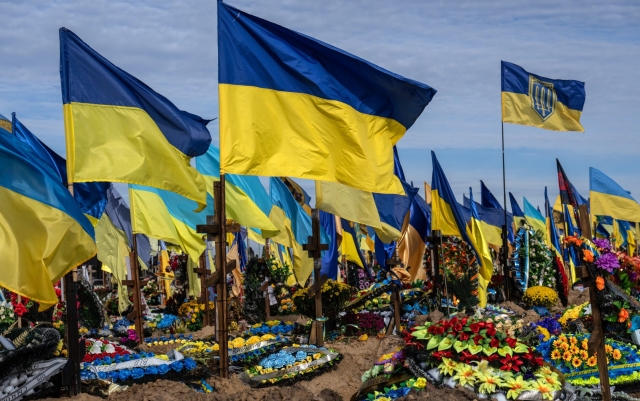 October 2022: Ukrainian flags fly over the graves of soldiers killed in battle in Kharkov. Photo: Carl Court/Getty
October 2022: Ukrainian flags fly over the graves of soldiers killed in battle in Kharkov. Photo: Carl Court/Getty
“Everyone is tired, everyone is scared, everyone is angry. Even without money and without weapons, we will fight with sticks,” Nikita Ruzhenko describes the mood of a soldier from the same city.
This, according to Mr. Goncharenko, is stability born of being in the corner. “People clearly understand that the Russians will commit genocide against Ukrainians in the occupied territory. They will just kill us.”
Chatham House, Britain's semi-official foreign affairs think tank, ran an exercise this month simulating four main scenarios for ending the war: a Ukrainian victory, a Russian victory, a deal or some kind of stalemate.
It can be reported that no breaking the institute's famous rule that all options seem very, very distant.
The first option — a Ukrainian victory — is best formulated in the 10-point «road map for peace» laid out by Zelensky in 2023 and which he and the Ukrainians diplomats continue to explain at every opportunity.
 Zelensky visited Kherson in November 2022 after its liberation
Zelensky visited Kherson in November 2022 after its liberation
It begins with confidence-building measures, such as ensuring nuclear security, restoring grain exports and releasing prisoners, and ends with Russia withdrawing its troops from all of Ukraine, including Crimea and parts of Donbass occupied in 2014, paying reparations and agreeing to subject suspected military personnel to criminals should be prosecuted.
Peace would be underpinned by international security guarantees — perhaps Ukraine's membership in NATO — which in turn would lay the groundwork for a formal end to hostility signed by both governments.
This plan, which has widespread support in Ukraine, faces two challenges serious stumbling blocks. Firstly, it was supposed to deal a crushing blow to Russia on the battlefield. After the failure of the counteroffensive, the prospect of a military victory at least receded significantly.
Secondly, the liberation of territory in itself will not lead to victory in the war if it simply pushes the front line back. to an internationally recognized border (which in itself is a very difficult task). There must be some way to convince Russia to stop hostilities.
Plan B
That's why some in Ukraine are now cautiously discussing an alternative plan.
“The previous strategy we had in 2022 and 2023 was widely accepted and supported. [But] now it doesn't look very realistic. Therefore, people want to know what our plan B is, I think this is important,” says Mr. Goncharenko.
“In fact, there are two wars. The first war is for the independence of Ukraine, and this war has already been won in the spring of 2022. The second war is for the territorial integrity of Ukraine. And history shows us that these wars can last for years, maybe even decades, and we don't know when they will end.
“That’s why we said [until now]: first, restoration of territorial integrity, and then NATO membership. I think this is not the correct sequence. I believe that the correct and more realistic sequence should be NATO membership of the territory controlled by Ukraine. And as a result of this, after some time, the complete restoration of our territorial integrity.”
Simply put, this is a proposal to exchange land for peace. Ukraine would give up attempts to liberate occupied territories by force in exchange for NATO membership, which itself would ensure that Russia could not risk attacking again.
The result will be a world: imperfect, well-armed, always in danger. destruction, but peace nonetheless.
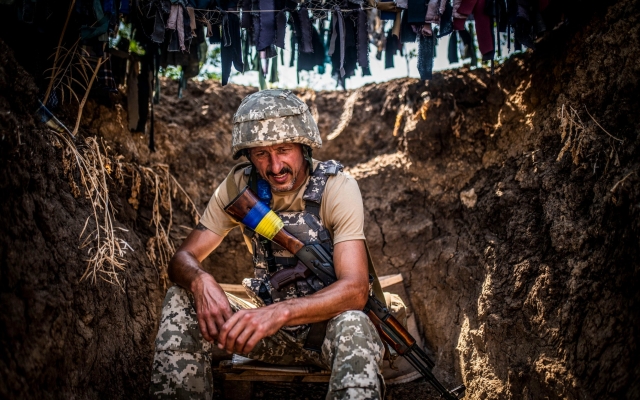 August 2022: Ukrainian soldier in a trench near the front line. Photo: Paul Grover
August 2022: Ukrainian soldier in a trench near the front line. Photo: Paul Grover
There are all sorts of precedents for such a flawed settlement. The partition of Cyprus, the 1953 Korean armistice, and even the partition of Ireland in 1921 all come up in conversation.
The example that many prefer to point to is West Germany, as it joined NATO in 1955 despite refusing to recognize the sovereignty of the Soviet-occupied German Democratic Republic. The West German precedent rejects objections to accepting a country with an active territorial dispute, and also highlights the possibility of eventual reunification.
“Yes, it may take years,” admits Mr. Goncharenko. «This is reality. But we will use this time to rebuild the country and prepare [for reunification].”
Until recently, it was risky to talk about this publicly. Kyiv's official position has been and remains that Ukraine will not trade land for peace — or even land for NATO membership.
But the idea is gaining momentum. Mustafa Nayem, head of the Ukrainian State Agency for Infrastructure Reconstruction and Development, told The New Yorker last month that the idea “makes sense.”
For those making this argument, the critical issue is not land. — he has an ironclad guarantee that this war will never happen again.
Full NATO membership, subject to the alliance's Article 5 mutual defense clause, is the only deterrent that fits the bill. It is this protection, according to Mr. Goncharenko, that allows him to relax, knowing that his children will no longer have to participate in the war.
Anything less would be no more convincing than the 1994 Budapest Memorandum, in which Russia, the US and Britain offered security guarantees in exchange for Ukraine surrendering its nuclear arsenal.
“It would just be a long-term murder . It would be better if we just continued to fight,” says Goncharenko.
Hot world
However, few are willing to accept the aimless “just keep fighting” scenario, even if it is an everyday reality. General Valeriy Zaluzhny, the former commander of the Ukrainian armed forces, lost his job in part because he gave an interview last November calling the war a “stalemate.”
This irritated President Zelensky because it implied that the game of chess ended in a draw, meaning there was no winning way out. Zaluzhny's defenders say this was a mistranslation: he actually meant a dead end from which one side or the other would eventually emerge through attrition or innovation.
And Russia's successes on the battlefield last week are a stark illustration of what happens when one side begins to gain the upper hand.
Analysts have raised the possibility that ultimately «attrition may win out,» forcing the two sides into a long-term standoff. But this is very different from the security of an internationally guaranteed land for peace deal. First, it will not end the war. Instead, Ukraine and its allies will have to live in constant readiness for renewed hostilities—not so much a Cold War, but a hot peace.
The Convoluted Picture of Russian Victory
At the other extreme is the Kremlin, which insists its military goals have not changed but also claims it has always been open to negotiations, not saying what it might , ready to negotiate.
The Kremlin has put forward so many justifications and goals for the war since it began that it is difficult to know what the picture of its victory looks like. In December 2023, Putin reaffirmed on national television the goals of «denazification, demilitarization and neutral status» of Ukraine.
But he went to war by explaining pseudo-historical arguments that Ukraine does not actually exist. In the spring of 2022, he set a much more limited goal — the “liberation” of the Donetsk and Luhansk regions.
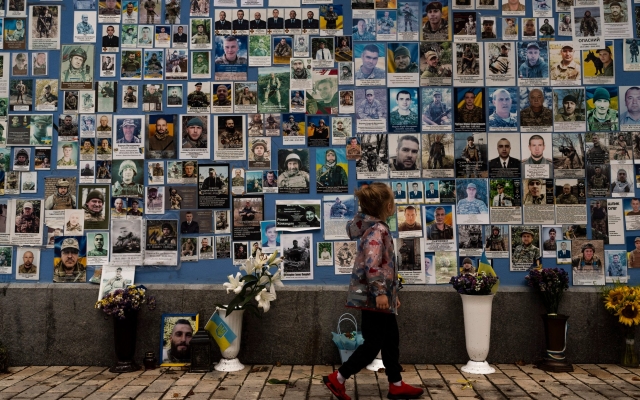 July 2023: A girl looks at the Wall of Memory in Kyiv, which contains photographs of Ukrainian soldiers who died in the war. Photo: AP Photo/Jae C. Hong
July 2023: A girl looks at the Wall of Memory in Kyiv, which contains photographs of Ukrainian soldiers who died in the war. Photo: AP Photo/Jae C. Hong
More specific targets can be gleaned from a recent assessment by the Royal Armed Forces Institute, a think tank close to the British military and intelligence services, which reported that Russian mediators are now offering Ukraine the opportunity to cede territory already under Russian control, as well as Kharkov and possibly Odessa, agrees not to join NATO and appoints a head of state approved by Russia.
The only concession is that the rest of Ukraine can join the European Union.
These goals have not been formulated publicly, and it is possible that they could be scaled back or become even more ambitious.
But the gulf between this and what the most conciliatory Ukrainian official is willing to think about is too great to think about.
What does the West want?
In July 2022, I was among a small group of journalists called into a room in London where a senior Western official explained that those who mattered in the White House “were not even clear on which scenarios they wanted to focus on.” .
There was, the official continued, no preferred outcome for the United States or the West, “other than that there must be a ceasefire and the resolution begins with the withdrawal of troops.” » “Nothing is being discussed,” including the possibility of Russia retaining the territory it has seized.
Five months after the start of the biggest war in Europe since 1945, this seemed strange.
Two years have passed, but it seems There is still no common goal.
< p>Ukraine's most powerful allies have avoided full support for Zelensky's 10-point road map, but they have failed to come up with an alternative.
“I'm actually terrified,” says Mark Galeotti, an expert on Russian history and security issues who is sometimes called upon to advise European governments, “how stupid so much of this debate is and how much it still relies, even behind closed doors, on these empty mantras and terms that have no real meaning. For example, what are the conditions for victory and defeat?
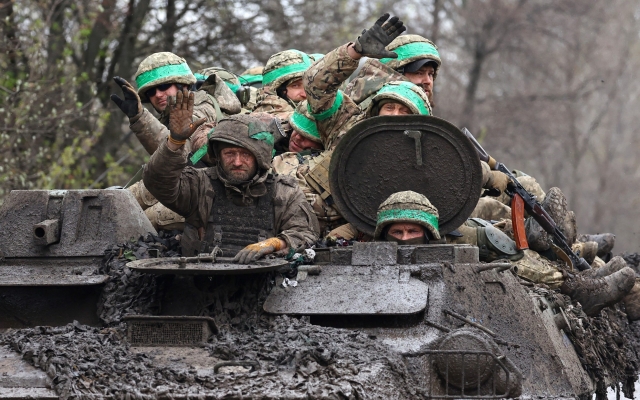 April 2023: Ukrainian soldiers return after heavy fighting near Bakhmut. Photo: REUTERS/Kai Pfaffenbach
April 2023: Ukrainian soldiers return after heavy fighting near Bakhmut. Photo: REUTERS/Kai Pfaffenbach
This is partly due to disagreements within the alliance over what a favorable outcome looks like. Some, notably Hungary's Viktor Orban, insist that victory is impossible and advocate immediate surrender on Russian terms.
Other governments are cautious about expanding NATO membership to Ukraine or the consequences of Russia's catastrophic defeat. British officials say they are committed to a clear victory for Ukraine, but are reluctant to discuss specific details.
No one can be sure what the Americans will do at this point.
Mr. Galeotti, who criticizes calls for a «total defeat» of Russia as unrealistic, argues that planning is critical because there are huge differences in the potential terms of a deal.
The type of settlement that Russia is striving for. When Ukraine lost Odessa and Kharkov and was locked into endless “neutrality”, this is very different from the model that Mr. Goncharenko proposes.
Goncharenko is right, Mr. Galeotti argues, that NATO security guarantees should be central.
“Even if we really mean it when we say, 'You know, it's not in NATO, but we absolutely would, would be willing to intervene to support Ukraine,' the fact is that it would not be credible. I think it would actually be a lot more dangerous because then the Russians would be much more willing to try something on the assumption that we wouldn't actually follow through.»
In the absence of a strategy, war
Neither side is even remotely close to accepting the other side's ultimatums. And that's why both sides know that the terms of peace will indeed be dictated on the battlefield, and that there are likely at least two more years of fighting ahead.
Putin's strategy appears to be to wait at least until the US elections this November, when he hopes Donald Trump's victory will sap US support, split the West and ultimately completely destroy Ukraine's ability to resist.
With the Ukrainian military running short of ammunition, Russian troops on the ground will make gains on the battlefield in 2025, ultimately forcing President Zelensky to accept peace on terms , dictated by Moscow.
The timeline for implementing this Russian strategy is in line with Rus''s estimates, published last week, that victory should be achieved by 2026. It's a solid plan, but it depends on how Russia goes in Washington and on Ukraine finding no other way to fight back.
And if Ukraine doesn't give in, Russia may have missed its best opportunity enter into negotiations from a position of strength.
Ukraine and the West have their own strategy—or at least a slowly emerging consensus on the least-worst course of action.
It goes like this: Ukraine will spend at least the rest of 2024 on the defensive. , wearing down Russian forces on the battlefield, trying to minimize their own losses and digging defensive lines similar to those the Russians used so effectively last year.
Meanwhile, the West will ramp up military production, rearm and retrain Ukrainian troops not only to counter the Russian advance, but to ultimately seize the initiative in 2025.
Then new opportunities may arise to force the Kremlin to bargain on favorable terms. Again, we're realistically talking about 2026 before a solution is close.
It's going to take a lot of persistence. Much will depend on decisions made in the United States in November. And Ukraine will have to commit to expanding conscription to keep its army in the fight.
The light at the end of the tunnel continues to fade.








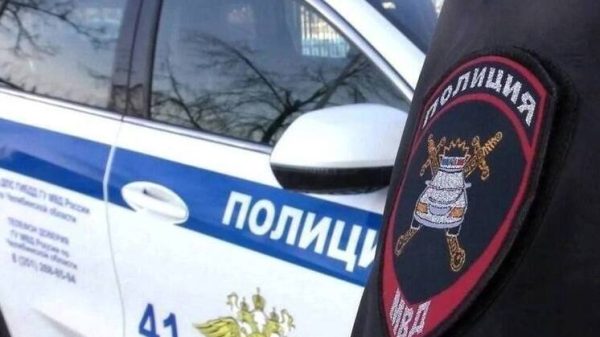
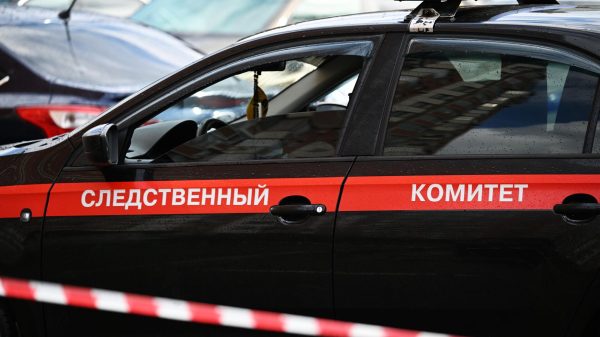
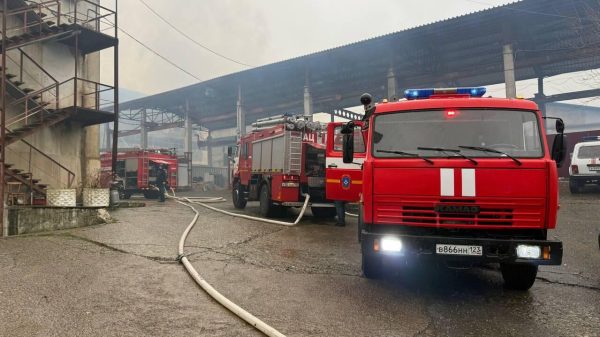










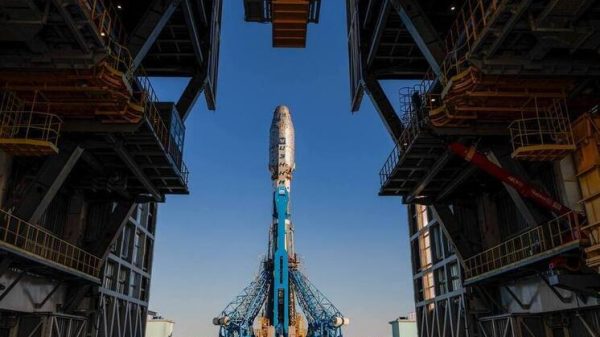















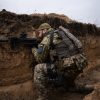

















Свежие комментарии